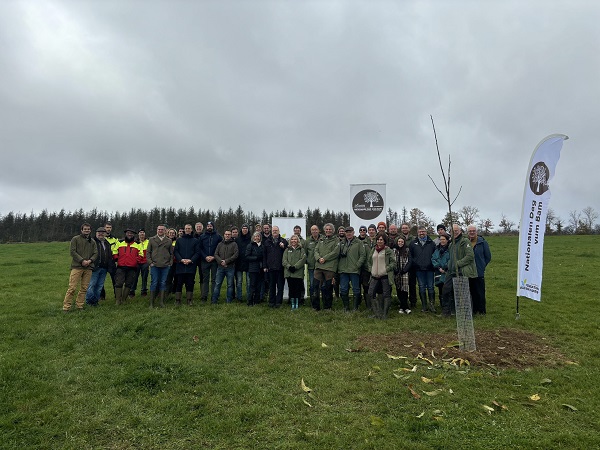 Credit: Fondation Hëllef fir d'Natur
Credit: Fondation Hëllef fir d'Natur
On Thursday 14 November 2024, the Fondation Hëllef fir d'Natur launched its annual tree planting campaign, under the high patronage of the Hereditary Grand Duke of Luxembourg, ahead of National Tree Day.
Each year on the third Saturday in November, National Tree Day aims to raise awareness and encourage public and private bodies, as well as individuals, to plant trees and shrubs and thus support biodiversity in rural and urban areas.
Chronicle.lu had the opportunity to speak with Frankie Thielen, Director of Fondation Hëllef fir d'Natur, to learn more about this initiative.
Chronicle.lu: Please tell us about the significance of National Tree Day and the involvement of Fondation Hëllef fir d'Natur in this annual initiative over the years.
Frankie Thielen: National Tree Day is always a very important date in the calendar year for the Hëllef fir d'Natur foundation. Our foundation was actually the original initiator of the day. It has been held every year since 1992. The day is now well known throughout Luxembourg and many municipalities, companies and private individuals take part. The original idea of emphasising the importance of trees for society has therefore worked. However, to keep the topic current, you need to communicate about the importance of trees and forests throughout the year.
Chronicle.lu: Several events took place again this year for National Tree Day. How did Fondation Hëllef fir d'Natur mark the event?
Frankie Thielen: The foundation always starts the day with a tree planting event on the Thursday before in the presence of the Minister for the Environment, the director of the ANF [Nature and Forest Agency] and the mayor of the respective municipality where it is taking place. This year, the event took place in the municipality of Kiischpelt, near the town of Wilwerwiltz. In the presence of Minister [Serge] Wilmes, the director of the ANF, [Michel] Leytem, and the mayor, [Yves] Kaiser, 20 deciduous trees were planted on a treeless meadow. In addition, the children from the local school planted about 100 metres of hedge.
Chronicle.lu: How many trees has Fondation Hëllef fir d'Natur planted in Luxembourg in recent years?
Frankie Thielen: In the last planting season, 2023/24, the foundation reforested an area of more than 10 hectares with 23,000 native trees. In addition, several hundred fruit trees of old varieties were planted. The 2024/25 planting season is not yet over. But the numbers are expected to be even higher.
Chronicle.lu: We understand that about one-third of Luxembourg's land surface is covered by forests. However, studies have also shown that more than half of trees in these forests are in very poor condition (badly damaged), or even dead. Based on your knowledge and experience, what are the main threats to trees in Luxembourg and how can/should these be addressed?
Frankie Thielen: Our forests and trees have suffered greatly in recent years. The several very dry summers in a row were a big problem for many tree species, especially spruce. This caused drought stress and made them susceptible to insect pests. A massive infestation of bark beetles then led to the death of many spruce trees. The trees also suffer from an excessive density of wild animals. In particular, deer and stags bite many young trees and prevent them from growing. To counteract these two main problems, our foundation plants species-rich mixed forests and no monocultures. The aim is to find out which tree species can best adapt to the changing climate. To prevent damage caused by wildlife, areas with young trees are fenced off. This protection is very effective, but also very expensive.
Chronicle.lu: What are some of the most common trees in Luxembourg? In what ways might invasive tree species represent a threat to native species?
Frankie Thielen: Common tree species in Luxembourg are still beech and oak. And especially in the north, spruce. However, many associated species such as the common whitebeam, bird cherry, etc. have become rare because they were not economically interesting in the past. These species should be supported more in the future.
There are no highly invasive tree species on a large scale yet. The robinia, which originally comes from North America, is present to some extent and can spread quickly. Cherry laurel hedges, which are often planted as privacy screens in gardens, can also quickly spread into our forests. In any case, care should be taken to avoid this. In general, private individuals should also favour native trees and plants. After all, all of our animals depend on or are partially dependent on these species.
Chronicle.lu: How can the public get involved, for example in supporting tree planting efforts?
Frankie Thielen: Of course, everyone is free to plant trees or hedges in their own garden (if they have one). As described above, native species should definitely be used here. If you don't have a garden or an area where you can do this, you can of course support the foundation's projects with donations. We will continue to plant as many native trees and hedges as possible. This is more necessary than ever.
For further information about Fondation Hëllef fir d'Natur and its projects, visit https://www.hellefnatur.lu/en








